The request for a day trading strategy that allows one to pass a €15,000 prop trading challenge in just three days, with a 100% success rate while strictly adhering to all rules, reflects a strong interest in a fast and secure way to succeed in proprietary trading. However, it is essential to understand the complexity of financial markets and the specific requirements of prop trading challenges to set realistic expectations. This report analyzes the typical rules and requirements of such challenges, the probability of guaranteed success in day trading, the feasibility of such a short timeframe, and the key elements of a pragmatic day trading approach.
The €15k Prop Trading Challenge in Detail
Prop trading firms offer various challenge formats with different account sizes, and a challenge with a starting capital of €15,000 is a common option. It is important to understand that this capital is usually virtual during the evaluation phase. The goal of the challenge is to demonstrate the trader’s ability to trade profitably on this simulated account and apply effective risk management to qualify for a funded account with real capital.
To pass a prop trading challenge, traders typically have to reach a specific profit target within a set period. For a €15,000 account, these targets are typically between 8% and 10% in the first phase, and about 5% in subsequent phases of multi-step challenges. Some firms offer one-step challenges, where the profit target can be around 9% to 10%. A 10% profit target on a €15,000 account means generating a profit of €1,500. Achieving this consistently in just three days while adhering to risk rules poses a significant challenge.
A central aspect of prop trading challenges is the strict rules regarding risk management, particularly drawdowns. Maximum daily loss limits are typically 3% to 5% of the initial account balance (e.g., €450 to €750 for a €15,000 account), while total maximum loss limits are generally 6% to 10% (e.g., €900 to €1,500 for a €15,000 account). Exceeding these limits leads to disqualification, even if the profit target has been reached. Risk management often takes priority over simply reaching the profit target. Staying within these drawdown limits while trying to achieve substantial profits in just three days requires an extremely precise and potentially high-risk approach.
Many prop trading firms require traders to trade for a minimum number of days (e.g., 3-5 days) to qualify, even if the profit target is reached earlier. Some may even require a profit on each of those days. The three-day timeframe mentioned by the user may align with the minimum trading days at some firms but does not guarantee success within that period if the profit target is not reached or other rules apply, such as a minimum profit per day.
The leverage for challenge accounts can be substantial (e.g., up to 1:125 for forex, 1:20 for indices). While high leverage offers the potential for quick profits needed to reach the target in three days, it also increases the risk of drastically exceeding drawdown limits even with small adverse price movements. Prudent use of leverage is therefore crucial.
Prop trading firms often emphasize consistent trading performance and adherence to specific trading styles. Some may have restrictions on news trading or the use of expert advisors (EAs). A strategy that focuses on a single high-risk trade to reach the target in three days might be considered inconsistent and raise concerns at the prop trading firm, even if it is profitable.
The Illusion of Guaranteed Success in Day Trading
Research consistently shows that the overwhelming majority of day traders lose money. Success rates range only between 3% and 20%. Some studies suggest that up to 97% of day traders lose money in the long run. This makes a guaranteed 100% success rate in a prop trading challenge highly unlikely.
Even experienced and successful day traders incur losses. The goal is to have more winning trades and manage losses effectively. No trading strategy can guarantee a 100% win rate. Expecting never to have a losing trade, especially in a high-pressure environment like a prop trading challenge, is unrealistic.
Strategies labeled as “high probability” aim to increase the chance of success but do not guarantee it. The win rates of even well-tested strategies typically range from 50% to 70%. Aiming for win rates above 90% is often unrealistic and may indicate over-optimization. The user’s request for a 100% success rate suggests a misunderstanding of what “high probability” means in trading. True guarantees do not exist in financial markets.
Strategies that promise near-100% profits should be approached with extreme skepticism. They often involve very low profit targets, high-frequency trading with minimal risk-reward ratios, or may be based on flawed or selective data. Such strategies may not be sustainable or adaptable to different market conditions. Pursuing a guaranteed strategy might lead the user to choose a flawed or overly risky approach that ultimately results in failure.
The Timeframe: Assessing the Feasibility of Completing a Challenge in 3 Days
The average time to pass a prop trading challenge is usually 4–5 months. Some firms offer challenges with fixed timeframes ranging from a few weeks to several months. The user’s goal of three days is significantly shorter than the typical timeframe and indicates the need for extremely rapid and potentially unsustainable profit generation.
Many prop trading firms require a minimum of 3–5 trading days. While a three-day period may meet the minimum requirement for some, it leaves no room for mistakes or inconsistent performance. Even if the profit target were miraculously reached in three days, the minimum trading time might require additional trades, which could expose the account to further risk.
Attempting to complete a challenge in just three days would likely require taking very high risks to achieve the necessary profit. This significantly increases the likelihood of hitting daily or total drawdown limits and failing the challenge. The desire for rapid success directly contradicts the prop trading firms’ emphasis on risk management. A strategy aiming for a 10% profit in three days on a €15,000 account would need to generate an average daily return of over 3%, which is extraordinarily high and carries substantial risk.
Success stories of prop traders typically involve months or even years of learning, practice, and consistent application of strategies. Rapid success is rare and often unsustainable. These examples highlight that significant and lasting success in proprietary trading is a marathon, not a sprint.
Key Elements of a Pragmatic Day Trading Approach for Prop Trading Challenges
A realistic approach to a prop trading challenge requires a strategic framework based on solid day trading strategies, rigorous risk management, strict rule compliance, and psychological discipline.
Day trading strategies such as scalping, momentum trading, breakout trading, and range trading are commonly used in prop trading challenges. These aim to profit from intraday price movements. Although suitable for day trading, they do not guarantee quick success. The strategy choice should match the trader’s skills and the specific market conditions. It is advisable to rely on a well-tested trading strategy tailored to the challenge requirements and to avoid experimenting with new strategies during the challenge. Backtesting helps understand the strategy’s performance metrics and adapt it to the prop trading firm’s rules. Using a proven strategy increases the likelihood of consistent performance valued by prop trading firms. A solid knowledge of technical analysis—including chart patterns and indicators such as moving averages, RSI, MACD, and Bollinger Bands—is essential for identifying high-probability trading setups.
Risk management is the cornerstone of success in prop trading challenges. It is crucial never to exceed the maximum daily losses or total drawdown. Setting alerts to monitor these limits precisely is advisable. Exceeding drawdown limits is a main reason challenges fail. Capital protection is the top priority. Conservative position management with moderate leverage and limiting the capital risked per trade to a small percentage of the account balance (e.g., 0.5% to 1%) is essential. For a €15,000 account, this means risking €75 to €150 per trade. This approach minimizes potential losses and increases the longevity of the trading capital, making it easier to recover from losing trades without hitting drawdown limits. Strategic stop-loss placement based on technical analysis to limit potential losses per trade is also critical. Volatility should be considered when setting stop-loss distances. Proper stop placement is vital for risk control and should not be set too tightly, as this can lead to premature exits due to normal market fluctuations.
Strict rule compliance is essential. All prop trading firm guidelines should be thoroughly read and understood. Particular attention should be paid to rules regarding traded instruments, lot sizes, and prohibited strategies. Even minor rule violations can lead to disqualification. Consistent trading performance with steady, incremental gains is advisable rather than trying to reach the entire profit target with a few high-risk trades. Consistency is more valuable to prop trading firms than short-term volatility. They want to see that a trader can reliably generate profits over a longer period.
Psychological resilience is also crucial. It is important to stay calm and avoid emotional decisions driven by fear or greed. Sticking to the trading plan and avoiding impulsive actions is advisable. Emotional trading is a common reason for failure. Developing strategies to control emotions, such as taking breaks after losses or setting predefined trading hours, can be helpful. Realistic expectations are important. It should be understood that passing a prop trading challenge takes time and effort. Expecting guaranteed success within three days should be avoided. The focus should be on consistent strategy execution and sound risk management. Realistic goals help maintain motivation and prevent discouragement.
Case Studies and Real-World Outcomes
Although some traders achieve remarkable success in proprietary trading, their journeys typically involve significant learning curves, discipline, and time. Success stories often emphasize the consistent application of a proven strategy, strict risk management, and psychological mastery. These examples reaffirm that immediate success with a guaranteed strategy in proprietary trading is not the norm.
Success rates for prop trading challenges are generally low, demonstrating the difficulty of meeting the required criteria. This further underscores that a guaranteed 100% success rate is highly unlikely. Statistics on passing rates highlight the need for a well-prepared and realistic approach.
Mastering the Challenge: A Realistic and Sustainable Approach
The focus should be on developing a solid trading plan that aligns with the prop trading firm’s rules and the trader’s style. Consistent risk management is crucial to protect capital and avoid drawdown limits. Setting realistic daily and weekly profit goals that contribute to the challenge’s overall target without taking excessive risks is advisable. Patience and discipline are essential to wait for high-probability setups and avoid impulsive trades driven by the desire for quick profits. It should be understood that passing a prop trading challenge is a demonstration of consistent profitability and risk management over time, not a one-time event.
Conclusion: Probability and Disciplined Execution
Day trading and prop trading challenges are inherently probabilistic. No strategy can guarantee a 100% win rate or success within a specific timeframe. A disciplined and thoughtful approach that emphasizes risk management, rule adherence, and consistent execution of a proven strategy offers the best chance of success in a prop trading challenge. While the desire for quick success is understandable, focusing on sustainable trading habits and a realistic timeframe is crucial for long-term success in proprietary trading.

